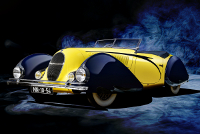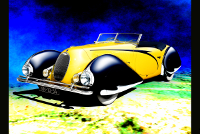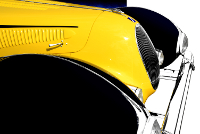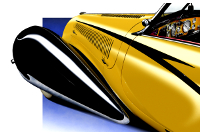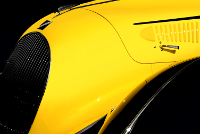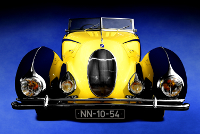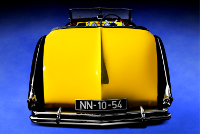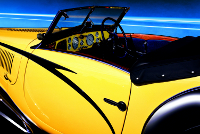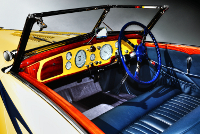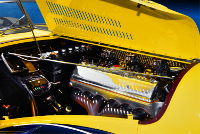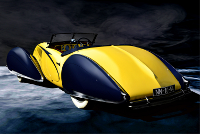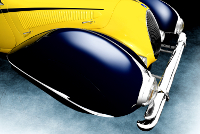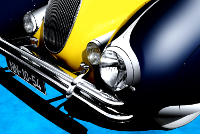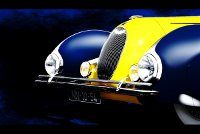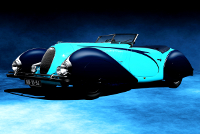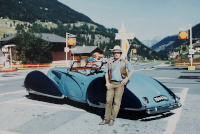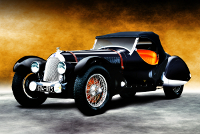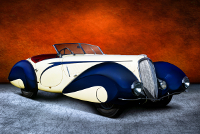Location:
Radnor Hunt Concours d'Elegance, 2016
Owner: J.W. Marriott, Jr. | Bethesda, Maryland
Prologue:
This profile is dedicated to Franck Frydman of France, whose enthusiasm kept 12cylinders going when the effort felt futile.
Special thanks to Mr. Richard Warth of Hertfordshire, England, whose father, John Warth, located and purchased #90019 in Portugal at the close of the Carnation Revolution. Richard's contribution brings light to his father's life and adventures. Image 22 arrives courtesy of Richard, depicting John Warth with #90019 somewhere in Europe following his acquisition of the car from the Contessa de Colhiva. And so I am deeply appreciative of the chance to fill in the gaps and describe the pieces of 20th century life this car witnessed.
Chassis #90019 was for some while the most popular car I profiled, a car most regard as one of the finest classics in the world. And yet, much of the history written about the car's life through the latter half of the 20th century involves either hint or rumor. To most, what we see is eye candy—eye-popping graphical candy for sure, but with less substance than one would like to support the extravagance. Thankfully, Mr. Warth reached out to close the proverbial loop, which provides us with one of the more complete perspectives on a superlative automobile.
- - - - - - - - - -
► Image Source: Nikon D750 (24.3 MP) | Images 2 and 20 finished at roughly 29 MP | Image 4 finished at 25 MP.
References:
- Mr. Richard Warth, former owner, written correspondence.
- Stobbs, William. "Les Grandes Routières Françaises" Les Éditions E/P/A, Vanves, France, (adaptation française par Paul Badré, 1990), page 158-159. For some short while I enjoyed the pleasure of corresponding with Mr. Franck Frydman. He once asked if I were interested in buying a few French titles on his shelf, and I agreed. This book is one of two I bought from Franck, and though it is a light survey of French classics, chassis #90019 does appear on pages 158-159 wearing its former two-tone blue livery. The other book I acquired is Pierre Dumont's, "Au Temps des Automobilistes," which (be not dissuaded by the cover) is a properly artistic book, and quite lovely throughout.
- UltimateCarPage: Featuring chassis #90019, by Wouter Melissen, May 16, 2007.
- RM Sothebys: Some information about the Figoni-bodied Talbot-Lago cars can be found in this article on chassis #90115.
Numerous sources state that the Count and Countess de Colhiva of Oporto, Portugal ordered chassis #90019 as new. The car wears coachwork from Figoni et Falaschi of Paris, build order #703. Chassis #90019 is one of two Talbot-Lago cars to use the torpedo design popularized by the Delahaye 135. This chassis is also one of three open T150-C cars built—each of which Figoni undertook between 1936 and 1938—and of those it is the only long-chassis car.
During the War, the Count and Countess fled to Brazil, but this Talbot-Lago remained in their possession back in Portugal for over 30 years. The family also owned T150-C #90020, a car bodied by Pourtout. At this stage, history flows by murky waters... One source notes that the car was first restored in 1985 by Carrosserie Le Coq. And when it came to the United States before the millennium, chassis #90019 still wore its original blue-on-blue livery. Around 2006 the light blue body changed to bright yellow, which is how most came to know the car under the Marriott family's stewardship.
John Warth, the Portuguese Talbot-Lago, and the Carnation Revolution Extraction
Mr. Richard Warth explains that his late father, John Warth, had in fact been the person who bought and exported #90019. John purchased the car in Portugal in the late 1970s from the Contessa who, at the time, Richard recalls lived in Paris. He writes, "Portugal during this time operated a ban on exporting vintage cars. The car was actually still in very good condition, only the fabric roof had deteriorated from the sun, otherwise it was very good. It always was a very exciting car and created a stir wherever it went. My dad exported many cars from Portugal during the political upheavals in the 70s when the country almost descended into revolution." This period is known as the Carnation Revolution, which ended the Estado Novo dictatorship in 1974.
Hunting for classic cars in Portugal at the fever pitch of unrest over the 15-year-long Portuguese Colonial War would have been thrilling, witnessing a mix of anti-communist and anti-authoritarian rule. Those who hunted for classics abroad must have felt a sense of urgency to preserve these cars as artistic and technological artefacts; they were not museum pieces at the time, merely old cars.
Richard explains that his father purchased and extricated other historically significant automobiles from similarly torrid political environments, in one trip moving the Delahaye "Star of India" and Farman A6B Super Sport Torpedo across the Himalayas, eventually flying them out of Kathmandu. This trip dates to the mid 1980s, and would unfortunately be the last for Richard's father, who passed away due to illness contracted during the escapade. Richard writes, "Thankfully I went on wild car hunts driving from England to India with him as a child, (and to Portugal), so I got to experience some of the adventures."
So I agree that it is important to call attention to those who risked so much for the sake of machinery. This facet of history is one we know very little about, mainly because so few took such risks, to say nothing of the political forces that reshaped the world in the latter half of the 20th century. Any car lucky enough to survive World War II would find itself in danger of forgetful demolition, because in those mid-century decades no one found much use for pre-War contraptions.
On that subject, I will leave the final word to Richard: "The cars have become the preserve of the wealthiest collectors, and I guess have finally found the status that coachbuilders like Figoni et Falaschi intended. The people who dragged them out of decaying barns or spirited them away from baying mobs in the grips of revolutionary fervor are however largely forgotten."
Rumors from across the Atlantic include mention of a serious accident sometime after the War, but this rumor appears false. Later owners confirmed Mr. Warth's recollection that the car remained highly original when it passed into his ownership, retaining some of its original paint, and that the car had stayed in Portugal through the middle of the 20th century.
Our conclusion can only echo the same refrain as so many others: Where this car appears, people are happy. The Figoni enveloppante design captivates onlookers, and the resplendent Talbot-Lago T150-C Cabriolet proves to be a foundational example of the most extravagant cars ever made.
Motor: 3,994 cc straight 6-cylinder, cast iron block, aluminum hemi-head | 90 mm x 104.5 mm | 7.0:1 compression
Valvetrain: overhead valve, 2 valves per cylinder
Aspiration: triple Stromberg EX32 carburetors
Power: 170 bhp @ 4,100 rpm (rated 140 bhp)
Drivetrain: Wilson 4-speed preselector gearbox, rear-wheel drive
Front Suspension: independent with wish bones, transverse leaf springs, and friction dampers
Rear Suspension: live axle with semi-elliptic leaf springs and friction dampers
Architecture: steel box-section chassis with aluminum coachwork by Figoni et Falaschi of Paris
Kerb Weight: 1,730 kg (3,814 lbs)
Wheelbase: 2,950 mm (116 inches)
Etymology:
The 'T150' designation carries over nomenclature that began in the last days of the original Talbot, with the Talbot 90 and 105, which signified the marque's sporting intentions. After company ownership passed from Rootes to Anthony Lago, the number series continued with the 120, which engineer Walter Becchia developed based on older plans. While the designations of cars from this era often reference power output, or even taxable power, it is likely that the numbers of the T-series refer to theoretical top speed in stripped down racing form. The 'C' designation is shorthand for 'competition,' denoting that Talbot-Lago prepared the car with various racing components. The 'S' designation is shorthand for 'sports.' Famous Parisian firm Figoni et Falaschi constructed the body, while we also include the chassis number in our title.
Figures:
The majority of Figoni et Falaschi-bodied Talbot-Lagos are closed coupes. However, from about 1936, Figoni et Falaschi bodied three T150-C cars as cabriolets; in order, these are #90111, our car, #90019, and also #90115. Of these, #90019 is the only long-chassis car. Also, #90019 is, I believe, one of two Talbot-Lago cars to use the torpedo design with nacelles (termed 'enveloppantes') that enclose the wheels, which the coachbuilder otherwise dedicated to the Delahaye 135 M chassis.
Figoni Torpedo: Comparing the Delahaye 135 Competition Court and T150-C Cabriolet
Comparing the Talbot-Lago to the Delahaye, (in particular Competition Court Roadster, chassis #48667, shown at right), chrome ornament on the skirts replaces the more common Art Deco motif, with the rear pieces darting inward along the body as on numerous Teardrop Coupes. At a glance, the proportions of this longer chassis mute the effect of the dip in the shoulders at the door, and give the car a more linear aspect. (Such is the difference of ten inches.) Compared to its Delahaye bretheren, the oval Talbot-Lago grille seems better suited to the coachwork, allowing the entire nose to integrate smoothly with the lights. Bonnet louvres are similarly well finished, with a stylized disc fronting the first, and smallest slit. The tonneau cover is also larger on this car, and the front and rear guards are both stacked attachments connected by upturned chrome darts. Note that chrome runs up and over the circumference of both front and rear fenders, and the tail lights receive the embellishment of chrome fairings.
Having once seen Talbot-Lago #90019 and Delahaye Chassis #48667 side by side, my feeling is that the Delahaye is more of-the-period—more a part of an artistic movement. After all, the Delahaye is the original bearer of the torpedo design, and its present-day fit and finish comes off as much more believable. In comparison, the Talbot-Lago is a harlequin; it knocks you sideways and overdoes everything an astounding design would otherwise do without the fanfare. The difference is like encountering the real versus the imagined. But having said that, we could simply argue that this Talbot-Lago is the end state—the most outrageous iteration of the renowned Cabriolet Torpedo.
On Perspective: Sculptural Qualities of the Cabriolet Torpedo
Perhaps the Cabriolet Torpedo requires a bit of height in viewing, otherwise its linearity makes curvature appear oblique, the pods acting more as nacelles that neither complement the fuselage, nor feel their fully rounded form. But with some height the composition grows plump and bombastic. As with the Teardrop Coupe, one begins to see the concept and how everything is meant to fit together. But that is the unfortunate nature of Figoni et Falaschi coachwork—all too easy to deconstruct, and very difficult to visually put back together with some semblance of harmony.
Original Livery: The Blue Talbot-Lago Torpedo
Flip to the end of this image set to glimpse the Cabriolet Torpedo in its original, two-tone blue livery. (Around 2006, the car was repainted in its high-contrast, yellow-on-blue mixture.) And for comparison, see also Delahaye 135 M Cabriolet, chassis #49150, (which is not part of our catalogue). Also known as the "Star of India," that Delahaye was originally red, but has been restored in a livery very similar to this car's original color scheme. The proportions are also similar, in that Delahaye #49150 and Talbot-Lagot #90019 are both long-chassis variants. In any case, I always like depicting lost variations of classic automobiles, and this blue-on-blue combination is one that has not been seen since the car first came to North America.
Last Updated: Mar 26, 2025

